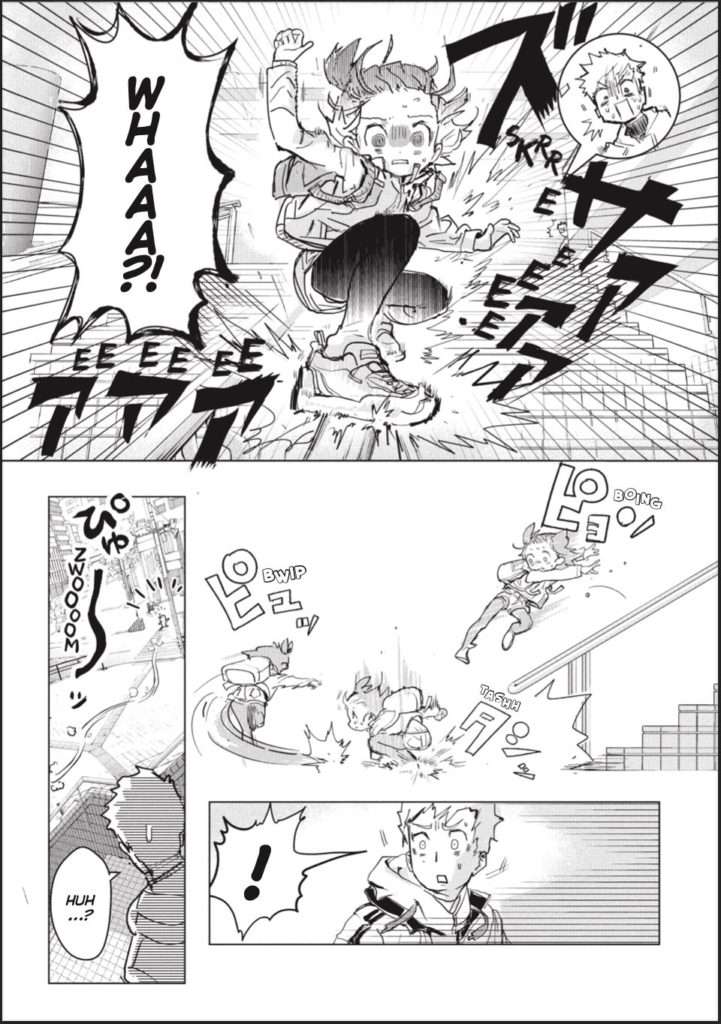Medalist Volume 1 Review
Most figure skaters retire from competition in their early twenties.
Tsukasa Akeuraji (26) has devoted his life to figure skating: ice dancing (when he realized he didn’t quite have enough skill to become a singles skater). But even that dream is fast becoming a fleeting memory as he has to earn a living… maybe coaching young hopefuls at the local ice rink. Which is where he first encounters a little girl speeding past on foot and – as you would – assumes she’s trying to get into the rink without a pass. A chase ensues. She gets away. Tsukasa doesn’t give up, even though she’s really fast! (The reasons involve a bag of worms and Mr. Kagoma at the ice rink reception desk, who keeps birds… )

Medalist © TSURUMAIKADA/Kodansha Ltd.
Later, as Hitomi Takamine, Tsukasa’s former ice dance partner, offers him coaching work, he’s about to refuse when meets the little girl again. She’s accompanying her mother who is very reluctant to sign Inori up for skating lessons because her older daughter has already tried – and failed. Tsukasa sees how desperate Inori is to pursue her dreams and tells the mother that he wants to give her a chance on the ice. Inori proves to be just as fast on the ice as on land. Tsukasa is seriously impressed. There’s no fear in her at all. She’s mastered stuff a normal beginner would be scared to do solo. She’s conquered the fundamentals all by herself.
However, despite her small stature, Inori is already eleven and because she has had no training, there’s so much to catch up with, not least gaining her preliminary badge (so that she can join a club and be able to compete, working her way up to the Level 7, the entry point to All-Japan and international events). Tsukasa, who has never coached before – but has seen Inori’s potential and inner drive and become inspired by her determination – has to keep devising unconventional ways to put his teaching points across to his diminutive student. His method for calming her nerves before the preliminary badge is inspired (and one to try!) – and his later analogies to the difference between ‘the strawberry taiyaki method’ and ‘the strawberry cheesecake method’ when learning double jumps not only make Inori hungry, but make sense to her.
Along the thorny path to achieving her goal, Inori is not just working to persuade her mother that she’s not going to go the same route as her big sister Meiko, but also encountering various other young aspiring ice figure skaters, some younger than her, and some are not friendly at all. However, a chance encounter with Hikaru Kamisaki, the ‘child prodigy’, inspires her – and introduces a gifted young skater who may well be her rival one day but is generous enough to encourage her into trying new things on the ice.
Mangaka Tsurumaikada has obviously got the ice-skating bug, right down to breaking a bone while skating (that’s dedication!) and their deep interest in and knowledge of the sport shows on every page. When Tsukasa is coaching, we frequently are shown him demonstrating and explaining so that, as readers, we understand the technical issues – yet never feel overly preached at. The balance is just right between ‘enough information’ to help us understand what’s at stake and moving the story along. Tsurumaikada’s graphic style is lively and eclectically varied which suits the story really well (there are plenty of comedic touches too). But when we need to be convinced about Inori’s potential on the ice, we see some breathtakingly realistic action ‘shots’ and at one moment when Tsukasa takes to the ice with his small student, we (like the impressed watching mums) are shown what a graceful and talented skater he is. There are also many close-ups in which we can really feel Inori’s emotions; she may be very small for her age but she’s passionate about skating, her eyes radiating intense joy, or spilling over with tears of fury and frustration.
The relationship between coach and pupil is crucial to this story and what makes it such a compelling read. Both aspiring skater Inori and coach Tsukasa are driven individuals and watching him finding ingenious ways to impart his experience and knowledge and becoming an inspirational coach – as well as seeing Inori develop as a skater (frequent slips and falls included) makes for a fascinating read.
The petty rivalries between club parents and their children are also convincingly (and depressingly) portrayed. Prickly third-grader ‘Mittens’ Ryoka Miketa takes a liking to Inori. But it’s Inori’s uphill struggle to convince her mother to allow her to pursue her dream that’s the most affecting (it’s impossible not to wonder what disappointments her mother endured in her own childhood to try to protect both daughters this way).
This award-winning manga has already reached Volume 9 in Kodansha’s digital edition (#10 in Japan at the time of writing) but the print edition is very welcome, especially as we now know there’ll be the anime TV series to look forward to in 2025. The translation is by the ever-dependable Kevin Gifford, with a splendid range of lettering by Darren Smith to suit all the differing moods of Inori and Coach Tsukasa (not to forget all those essential sound effects!). Kodansha have published this in the large trade paperback size which suits the mangaka’s dynamic style and subject matter well, with the bonus of four colour pages at the beginning. There are plenty of extras, ranging from character profile splash pages to 4-koma fun, as well as two side stories: ‘Inori and the Birds’ and ‘Tsukasa and the Sushi’.
Medalist – from the very first pages – draws the reader in and keeps you turning the pages. The blend of a lively, inventive art style and a very human story about wanting something so badly that you’ll give everything you’ve got and more to achieve your dreams is a real winner in manga terms. Recommended – and not just for sports manga fans; Medalist has something important to say to everyone.
Read a free extract at the publisher’s website here.
Our review copy from Kodansha was supplied by Diamond Book Distributors UK.


